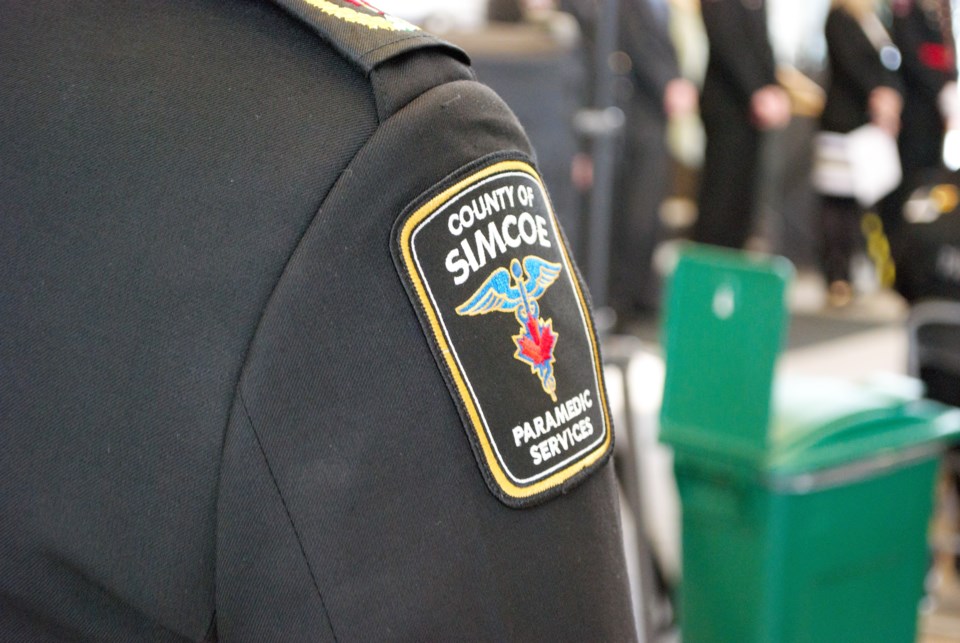Paramedic response times across Simcoe County are hanging on for the most part in 2022, but County of Simcoe Paramedics are hoping to do better.
During the Oct. 11 council and committee of the whole meeting, County of Simcoe councillors received an update on paramedic response times across the county and plans for the future to improve on those times. However, strain across the sector has been throwing a wrench in paramedics achieving those goals.
“Impacts associated with increasing transports, call volume, system-wide health human resource shortages, and hospital offload times may be influencing performance to target outcomes,” noted Shane Smith, deputy chief of paramedic services in his report to councillors.
And the problem isn’t going away.
In 2021, county paramedics saw an increase of 5.6 per cent in call volume compared to 2020. Mid-year forecasts for 2022 indicate a possible 10.4 per cent increase in calls. Also noted in the report, offload delay times experienced by county paramedics increased by 44 per cent between 2020 and 2021, with an additional increase of 16.4 per cent in the beginning of 2022.
Offload delays refers to the amount of time it takes to get a patient from the ambulance into a hospital.
“We have not seen the anticipated recovery of the health system and health human resources and have seen an increase in delays at hospitals impacting our ability to respond to emergency calls,” noted Smith in the report. “The staffing issues experienced across health care continue to impact our response times.”
Response time is measured from paramedic notification of a call to paramedic arrival at the scene of the call for service. In the context of a cardiac arrest, it is measured from paramedic notification of a call to the arrival of the first person on the scene of cardiac arrest who is able to apply a defibrillator.
Current target paramedic response times through the County of Simcoe are:
- Cardiac Arrest: The current target is a six-minute response at least 55 per cent of the time, and in 2021 it was reached 57 per cent of the time.
- Resuscitation: The current target is an eight-minute response 60 per cent of the time, and the 2021 actuals show it was met 65 per cent of the time.
- Emergent: The current target is a 10-minute response 70 per cent of the time, and in 2021, it was reached for 72 per cent of calls.
The current target is a 20-minute response for 85 per cent of urgent calls, 20 minutes for 90 per cent of less-urgent calls, and a 25 minute response for at least 90 per cent of non-urgent calls. In 2021, those response times were met for 87 per cent of urgent calls, 93 per cent of less-urgent calls, and 96 per cent of non-urgent calls.
New targets, which will be implemented between 2022 and 2024, will increase the cardiac arrest six-minute response goal to at least 60 per cent of calls. The eight-minute resuscitation response time goal and the 10-minute emergency response time goal will increase to 70 per cent of calls and 75 per cent of calls respectively. The response time goals for less-urgent and non-urgent times will be set at a standard of 90 per cent of calls reaching the goal time.
Looking at the first two quarters of 2022, paramedics in Simcoe County are meeting or exceeding all targets, except in cases of sudden cardiac arrest.
“I’m glad to see we’ve adjusted the targets. We are going to be moving toward some loftier times,” said Tiny Township Deputy Mayor Steffen Walma during Tuesday’s meeting, while asking about the drone pilot project undertaken by the county and whether implementation of that program was on the horizon.
The drone program, which was first unveiled in Oct. 2021 as a partnership between Volatus Aerospace and the County of Simcoe, saw a Matrice 300 drone designed to deliver defibrillators to remote locations in emergency situations. It could also be used for future applications such as EpiPen or naloxone delivery.
General Manager of Health and Emergency Services Jane Sinclair noted the county was still waiting on federal approvals for the drone program before it can be implemented beyond the pilot program.
On Oct. 11, county council unanimously approved receiving the report and establishing the new targets moving into 2023/24.



